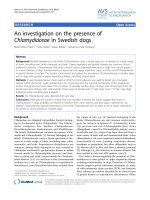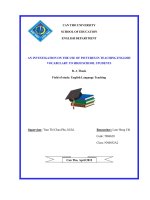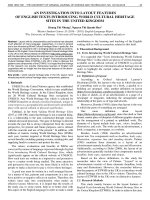An investigation on the traceability of the imported electronic components at the warehouse in ttti da nang co , ltd
Bạn đang xem bản rút gọn của tài liệu. Xem và tải ngay bản đầy đủ của tài liệu tại đây (1.04 MB, 80 trang )
DUY TAN UNIVERSITY
FACULTY OF ECONOMIC-FINANCE
MAJORS: LOGISTICS AND SUPPLY CHAIN MANAGEMENT
-------------------------- --------------------------
GRADUATION THESIS
TOPIC: " c ".
NAME
: DINH THI KIM NGUYEN
ID
: 25204710569
CLASS
: K25HP- QLC1
INSTRUCTORS
: DR. VENUS VERICABLANCA
HUYNH THI NGOC HIEN
Da Nang, May 2023
ACKNOWLEDGEMENT
Assigned by the teachers of the Faculty of Economics and Finance, Duy Tan
University , after nearly three months of doing the internship, I completed the
graduation thesis with the topic "Investigation and traceability of imported electronic
components". at the warehouse of TTTI Da Nang Co., Ltd ”.
To complete the assigned tasks, in addition to my own learning efforts, I also
have the dedicated guidance of teachers, aunts and uncles at businesses.
First of all, I would like to sincerely thank lecturer Venus Vericablanca, who
directly enjoyed the guidance as well as provided the necessary information for this
thesis, helping me to orientate the problem to do. in his dissertation.
I sincerely thank teacher Huynh Thi Ngoc Hien , my companion and guide
Venus for guiding me, explaining, editing the details to write the most complete thesis
during the internship period.
With the deepest gratitude, I would like to send to the teachers at the Faculty of
Economics and Finance, majoring in Logistic and Supply Chain Management, who
have imparted valuable knowledge to me during my study at the university. field.
Thanks to the guidance and teaching of the teachers, my research topic can be
completed well.
I would like to express my sincere thanks to Mr. Tran Van Dat and TTTI Da
Nang Co., Ltd for enthusiastically providing the information that I need at the
company, and creating conditions for me to have a good internship environment. , help
guide and acquire many useful knowledge . Everyone is enthusiastic to help, although
the company's workload is increasing day by day, the company still takes the time to
provide enthusiastic guidance. However, because of my limited professional
knowledge and my lack of practical experience, the content of the report is inevitably.
All officers and employees at enterprises to report this to be more complete.
Once again, I would like to send to you, friends, uncles and brothers and sisters at
businesses, sincerely and best thanks!
Da Nang , May 2023
Students
Dinh Thi Kim Nguyen
GUARANTEE
I hereby declare that this thesis is my work under the guidance of Ms. Dr Venus
Vericablanca and Ms. Huynh Thi Ngoc Hien.
The data and research results in this graduate thesis are honest. All documents are
referenced, the information cited in the thesis has been indicated with the source,
clearly describes the author's name, time, and place of publication.
Da Nang, May 2023
Students
Dinh Thi Kim Nguyen
LIST OF ABBREVIATION
STT
2
3
5
PCI
QC
NFC
RFID
Provincial Competitiveness Index
Quality Control
Near-Field Communications
Radio Frequency Identification
LIST OF TABLES WILL
The name of the tables
Table 1.1: TTT I Da Nang Company production department
Table 1.2 Human resource situation of the company in 2020-2022
Table 1 .3: Business results of TTTI Da Nang Co., Ltd in the period of 2020-2022
Table 1 .4: Number of long-term customers of TTTI Da Nang company
Table 1.5 : Balance sheet of TTTI company in 2020-2022
Table 4.1: Prepared interview questions for employees at the warehouse of TTTI . Co., Ltd
Table 4.2: General assessment of results after interviewing employees at TTTI Co.,
Ltd.'s warehouse
Table of results of information collection from employees at the warehouse of
THHH TTTI
LIST OF DIAGRAMS
The name of the diagrams
Diagram 1: Organization chart of the company's TTTI Da Nang.
Diagram 2: Traceability of components and attach information codes via Qrcode
Diagram 3: The process of importing and retrieving electronic events when returning to
the warehouse of TTTI Da Nang Co., Ltd
LIST OF FIGURES
The name of the figures
Figure1: Example of an analytics dashboard in a product traceability system
Figure 2: Example Product traceability data in the value chain
Figure 3: Illustration de QR code
Figure 4: Illustrating images small electronic components
TABLE OF CONTENTS
ACKNOWLEDGEMENT
GUARANTEE
LIST OF ABBREVIATION
LIST OF TABLES WILL
LIST OF DIAGRAMS
LIST OF FIGURES
TABLE OF CONTENTS
INTRODUCTION.......................................................................................................1
1. Background of the study.........................................................................................1
2. Problem Statement..................................................................................................1
3. Research aims and objectives:................................................................................2
4. Research structure :.................................................................................................3
CHAPTER 1: LITERATURE REVIEW AND THEORETICAL...........................4
1.1 Theoretical Background of The Study.................................................................4
1.1.1 Traceability game role:.....................................................................................11
1.2 Import and export process of electronic components information:.................12
1.2.1 Checking and retrieving goods :......................................................................15
1.2.2 QR code and barcode classification:................................................................17
1.3 Accountants check and make invoices:..............................................................20
1.3.1 Importance of key accessories:........................................................................20
CHAPTER
2:
ANALYSIS
OF
COMPANY'S
CURRENT
BUSINESS
CONDITION/STATUS.............................................................................................22
2.1 Company profile:.................................................................................................22
2.1.1 Company's Overview:......................................................................................22
2.1.2 Mission Statements of TTTI Da Nang:............................................................22
2.1.3 Organizational Chart of TTTI Da Nang Co., Ltd.:........................................23
2.2 The company's field of business activities:.........................................................25
2.2.1 Import of production materials:......................................................................25
2.2.2 Export of electronic components and electronic products:............................26
2.3 The situation of resources of TTTI Da Nang company:...................................27
2.3.1 Labor source:....................................................................................................27
2.3.2 Main resources:.................................................................................................28
2.3.3 Facilities:............................................................................................................ 28
CHAPTER 3 RESEARCH METHODOLOGY......................................................35
3.1 Research method used.........................................................................................35
3.2 Respondents of the Study:...................................................................................35
3.3 Data Gathering Method:.....................................................................................35
3.3.1 Primary Data:...................................................................................................35
3.3.2 Secondary Data.................................................................................................35
CHAPTER 4: PRESENTATIONS OF FINDINGS AND ANALYSIS OF DATA
..................................................................................................................................... 37
4.1 Current status of the component traceability process at the company:..........37
4.1.1 For the general situation in production:.........................................................37
4.1.2 For TTTI Co., Ltd.:..........................................................................................38
4.2 Using questionnaires to interview company employees:...................................39
4.3 Evaluation of interview results on the reality of accessing electronic
components at the warehouse:..................................................................................41
4.3.1 Group answer similar of interview results :....................................................41
4.3.2 The data presents the results of the overall assessment of the responses:....41
4.4 SWOT of product tracking process of components at TTTI co., ltd:..............42
4.4.1 Analysis SWOT traceability issues encountered d uring the usage of the
imported products of TTTI company:.....................................................................42
4.4.1.1 SWOT of Traceability System User satisfaction:............................................43
4.4.1.2 SWOT of Information:.....................................................................................44
4.4.1.3 SWOT of Intention to use:................................................................................44
4.4.1.4 SWOT of System and service quality:..............................................................45
4.4.2 Problem of SWOT traceability issues encountered d uring the usage of the
imported products of TTTI company:.....................................................................46
4.5 Overall assessment of SWOT factors for the traceability process of electronic
components at T.T.T.I Co., Ltd................................................................................46
4.5.1 Strengths............................................................................................................46
4.5.2 Weaknesses........................................................................................................47
4.5.3 Threats............................................................................................................... 47
4.5.4 Opportunities....................................................................................................48
CONCLUDE..............................................................................................................49
CHAPTER
5:
SOLUTIONS
TO
COMPLETE
THE
PROCESS
OF
TRACEABILITY OF IMPORTED ELECTRONIC COMPONENTS AT THE
WAREHOUSE OF TTTI DA NANG CO., LTD.....................................................50
5.1 Recommendations can be drawn out for better TRACEABILITY
SOLUTION to help address the issues identified:...................................................51
5.1.1 Solution in terms of personnel of the goods information retrieval
department at TTTI Co., Ltd.:.................................................................................51
5.1.2 Solutions in terms of technology application at TTTI . Co., Ltd...................52
5.1.3 Solutions in terms of the process of retrieving imported product information
to the warehouse:.......................................................................................................53
CONCLUSION..........................................................................................................55
CONCLUDE..............................................................................................................57
REFERENCES..........................................................................................................58
Table of results of information collection from employees at the warehouse of
THHH TTTI............................................................................................................... 59
INTRODUCTION
1. Background of the study
Electronic s industry is an important industry in the national economy of Vietnam
with a key position and a spillover effect on other industries. It is also a measure of the
level of economic and technical development of every country in the world. Grasping
that importance, domestic and foreign investors are investing in this electronic sector,
many large electronic agencies in the world have invested in building electronic
product manufacturing facilities with high technology in Vietnam such as Samsung,
LG, Foxconn, Fukang Technology, LG Display Hai Wind. Computer products and
electronic components are expanding products according to domestic and market
needs. to electronic technology national economy ( 2022 ) the growth rate of
computers and electronic components has surpassed PCI, which can become the
second largest key export group of Vietnam from 2019 to present. The domestic
market in Vietnam's electronic components industry still has certain advantages, such
as benefiting from the trend of shifting supply chains. The world's major firms have
been moving factories and production chains from China to surrounding countries.
Electronics industry is one of the professions that always carry a global and necessary
trend. By power always needs to be maintained to ensure the operation of equipment
and machines that support everyone's work and daily life. Since the government's
capacity always needs to be maintained, electronic components have been
manufactured to serve the needs of people to operate in the most comfortable and
efficient way.
2. Problem Statement
ITG Technology ( 2022 ) describe traceability in electronics manufacturing as the
ability to trace the history, location, and movement of a product or component through
the production process. Traceability is the ability to trace all processes from
procurement of raw materials to production, consumption and disposal to clarify
"when and where the product was produced by whom. Due to improving product
quality and the rise in safety awareness in recent years, traceability has been increasing
in importance.In TTTI Da Nang traceability becomes an issue in the production and
assembly area Several instances, in the production and manufacturing of the electronic
1
products with the use of the imported spare parts were always a failure due to the fact
that defective raw materials were discovered.
It is in this scenario that the problem exists and needs to be addressed. The
problem worsens when these spare imported parts as raw materials cannot be trace in
terms of its suppliers and even other identifiers cannot be determined. So, an initiative
to consider this issue for proper study and investigation to address the issue of
traceability of the origin of the spare parts that are defective. A traceability system is
needed to provide the data needed to detect and resolve inefficient processes or
repetitive work, resulting in errors and waste, especially in costs of raw materials, that
add up to the cost of a products in the electronics spare parts of the company for the
production of electronic products. Thus, the topic on traceability is considered in this
research project.
3. Research aims and objectives:
Research on traceability after import has focused on many different aspects of the
steps in the process of importing electronic components at TTTI Da Nang Co., Ltd.
converting companies in countries around the world. such as Taiwan, China, Japan to
Vietnam to .... More specific, many studies have recognized the importance of
traceability for imports. These focus on specific aspects of the electronic components
import process, several theoretical perspectives have been used to explain the
electronic component import traceability process in the TTTI Co., Ltd. in Da Nang.
This research project aims to determine the traceability system employed by
T.T.T. I Da Nang in order to come up with a better Electronic Traceability solution
that would help solve the many issues of defective small electronic spare parts
imported from the different suppliers abroad which cannot be traced.
Specifically, this project aims to find out the common traceability issues
encountered during the usage of the imported products of TTTI from the different
supplies of the small electronic spare parts.
a. Traceability System User satisfaction
b. Information
c. Intention to use
d. System and service quality
2
With these, recommendations can be drawn out for better traceability solution to
help address the issues identified.
4. Research structure :
Chapter 1: Literature review and theoretical
Chapter 2: Analysis of company's current business condition/status
Chapter 3: Research methodology
Chapter 4: Presentations of findings and analysis of data
Chapter 5: Solutions to complete the process of traceability of imported
electronic components at the warehouse of ttti da nang co., ltd
3
CHAPTER 1: LITERATURE REVIEW AND THEORETICAL
This chapter describes the literature that covers the theories related to traceability
of the imported electronic components use in the assembly and production of products
of the company.
1.1 Theoretical Background of The Study
Product traceability refers to the capability to track and trace products in your
supply chain from production or manufacturing to the end customer. This requires the
generation and organization of supply chain data, and is used to increase supply chain
visibility. Chopra & Mendel (2019) that s supply chain consists of all parties involved,
directly or states, in fulfilling a customer request. The supply chain includes not only
the manufacturer and suppliers, but also transporters, warehouses, retailers, and even
customers themselves. Within each organization, such as a manufacturer, the supply
chain includes all functions involved in receiving and filling a customer request. These
functions include, but are not limited to, new product development, marketing,
operations, distribution, finance, and customer service.
A supply chain is dynamic and involves the constant flow of information,
product, and funds between different stages. W hen a customer makes a purchase
online from Dell Computer, the supply chain includes, among others, the customer,
Dell's Web site, the Dell assembly plant, and all of Dell's suppliers and their suppliers.
The Web site provides the customer with information regarding pricing, product
variety, and product availability. Having made a product choice, the customer enters
the order information and pays for the product. The customer may later return to the
Web site to check the status of the order. Stages further up the supply chain use
customer order information to fill the request. That process involves an additional flow
of information, product, and funds among various stages of the supply chain.
The objective of every supply chain should be to maximize the overall value
generated. The value (also known as supply chain surplus ) a supply chain generates is
the difference between what the value of the final product is to the customer and the
costs the supply chain incurs in filling the customer's request.
Supply Chain Surplus = Customer Value – Supply Chain Cost
The value of the final product may vary for each customer and can be estimated
by the maximum amount the customer is willing to pay for it. The difference between
4
the value of the product and its price remains with the customer as consumer surplus .
The rest of the supply chain surplus becomes supply chain profitable , the difference
between the revenue generated from the customer and the overall cost across the
supply chain. For example, a customer purchasing a wireless router from Best Buy
pays $60, which represents the revenue the supply chain receives. Customers who
purchase the router clearly value it at or above $60. Thus, part of the supply chain
surplus is left with the customer as consumer surplus. The rest stays with the supply
chain as profit. Best Buy and other stages of the supply chain incur costs to convey
information, produce components, store them, transport them, transfer funds, and so
on. The difference between the $60 that the customer and the sum of all costs paid by
the supply chain to produce and distribute the router represents the supply chain
profitable. Supply chain profitability is the total profit to be shared across all supply
chain stages and intermediaries. The higher the supply chain profitable, the more
successful is the supply chain.
An overview of technologies needed for product traceability shows that
traceability requires some combination of the technologies and technical processes,
although not all are mandatory. One is a system for generation of unique codes or tags
for products, from thousands to hundreds of millions. This is often referred to as
“product serialization”. Hardware and process for printing and applying unique
identifiers as barcodes, QR codes, data matrix, or electronic chips (RFID, NFC) on
product packaging, cases, and/ or pallets is also one important factor. Devices for
scanning codes on products along the supply chain such as cameras, chip scanners,
handheld devices, and smartphone-based mobile apps. Also, logistical unit tracking for
containers, trucks, etc. – often with GPS and environmental sensors. An integrations
between your Enterprise Resource Planning (ERP) and Manufacturing Execution
System (MES) systems, printing, and warehouse systems, and your traceability
platform to capture all relevant supply chain events at source, Finally a product
traceability software system or software platform that provides a single source of truth
across your supply chain data sources.
Imported electronic components are an integral part of electronic circuits.
Meanwhile, the electronic circuit is the brain for the machines and devices to operate.
Electronic circuits are known as basic electronic components. They may be a separate
5
component or may be contained in a separate device with defined features. Electronic
components usually have two or more electrical connectors. They will be connected
together to create a separate electronic circuit by soldering to an internal circuit board.
Traceability of these electronic components is considered the "key" to initiate trust for
users. For imports, traceability is indispensable to help businesses conquer the market.
Capital requires profit margins on origin and quality of goods. (In company
warehouse) International Organization for Standardization - ISO defines traceability as
the ability to identify and track the history of a product through data. whether data
format was written back. Traceability delivers significant value to businesses with
complex supply chains and distribution networks by detecting parallel imports,
improving distributor inventory management, simplifying streamline product recalls,
support regulatory compliance, help achieve sustainability goals, and communicate
product provenance to end customers.
A key challenge for supply chain traceability programs is how to collect data in
the “middle part” of the supply chain when products are in the custody of distributors
or partners. channel work. In some industries, such as food and beverage and industrial
goods, brands have limited leverage over distributors and therefore limited or no
ability to collect supply chain data from them. "The essence of traceability is the
ability to track and identify a component unit through each work segment of the
production and business process in the company ". When the product is stamped with
traceability, it means that consumers, manufacturers and businesses will be able to
trace a product from the time of production to the time it is released to the market,
such as from the source, materials, and place of production . export, design, shipping,
agency, retail.
Product traceability focuses on attaching a unique identifier or code to each
individual product and maintaining a record of each product's journey through the
supply chain. This usually requires scanning equipment and people to scan the product
and its box, pallet, etc. at multiple points in the supply chain. Traceability provides
significant value to businesses with complex supply chains and distribution networks
by detecting parallel imports, improving distributor inventory management,
simplifying product recalls, helping with regulatory compliance, helping achieve
sustainability goals, and communicating product origin to end-customers. There are
6
several benefits of traceability that can be explore. One is to order parallel imports and
product diversion; monitor distribution partners. Brands use supply chain data to
understand how products are reaching the market, how their distribution network is
performing, and whether or not distributors are violating their contracts and selling to
unauthorized markets. One key challenge for supply chain traceability programs is
how to capture data in the “middle” of the supply chain when products are in the
custody of the distributors or channel partners.
In some industries, such as food and beverage and industrial goods, the brands
have limited leverage over the distributor and thus limited or no ability to gather
supply chain data from them. Reasons why it's difficult to get supply chain data from
distributors include d istributors closely guard how they distribute to prevent being
disintermediated by the brand.; distributors have a fixed workflow across all brands
they distribute for, and are unwilling to use special systems or devices to manually
scan crates, pallets, or boxes for just one brand. It's not feasible to perform data
integrations with each distributors' ERP or Warehouse Management systems due to
technology limitations.
Modern traceability systems address the above challenges for obtaining supply
chain data from distributors in two ways one has a target market for each product. The
traceability system maintains a destination or target market for each product via its
unique code. Scan data from endpoints in the supply chain – consumers, customers,
professional users, or inspectors, reveal if products were distributed in an unauthorized
way. Second make it easy for distributors to scan products without an IT integration or
dedicated hardware. Smartphone-based mobile apps for scanning QR codes, RFID,
and NFC on boxes, crates, and pallets can make it significantly easier for distributors
to fill in blind spots in your supply chain, avoiding the need for stakeholders for
integrations across many. End-user data from connected packaging campaigns is a key
benefit for brands. By incentivizing users to “scan” or engage with the packaging,
more data can be gathered while offering end-users useful information.
Another benefit of traceability is the demand forecasting (supply and demand
management), distributor inventory management, sales and operations planning
(S&OP). Product traceability can enable better demand forecasting and distributor
inventory management, with two categories of benefits: Visibility into distribution
7
center operations (both in-house and external distributors) can be used for forecasting
demand, improving downstream inventory management, and sales and operations
planning ( S&OP). This is especially important for products which have seasonality or
promotions. Better demand management results in less shortages or overstock and
better cash flow management. Knowing the type and amount of inventory sitting in
distribution centers can make the brand aware of old products which need to be
expedited to market and replaced by newer ones.
Also, trace recalls, returns, damaged goods and defects, and products with
warranty claims.
Traceability systems can help identify products that have been
recalled and trace them through their distribution path and further upstream to their
manufacturing and production. Traditionally, tracing recall or damaged goods have
been manually done using text codes with batch, lot, and serial numbers printed on
products. This approach lacks unit-level supply chain traceability data and a channel
for customer engagement. In modern traceability systems, unit-level tags on each
product provide distribution and shipping information for each item, including the
production data (batch, lot) and logistics or shipping data (box, crate, pallet) across
points in the supply chain. Companies use this data to identify issues in their
distribution that are impacting product quality and in turn their profit margins.
Forth, the regulatory and trade restrictions compliance. Many industries are
regulated such that products and their ingredients, raw materials, or other inputs must
be traceable to the unit level. This can only be accomplished at a reasonable cost using
serialization – the printing, labeling, or even laser marking of unique codes on
products and packaging. Examples of regulatory requirements related to product
serialization include: The pharmaceutical industry is required to use serialized codes
on products for the purpose of traceability at the batch and lot level. Medical devices
require use of government-registered unique device identifiers (UDIs). In many
markets tobacco products must have unique identifiers. Foods in the US which contain
GMO ingredients must be labeled as such—one officially accepted method is using
QR codes. Alcoholic or other products which are not legally permitted to be exported
to a specific market are tracked by brands to prevent their entrance into those markets.
Finally, circular economy, recycling, and carbon footprint tracking and reduction.
Traceability enables emerging business models and practices where the product or
8
product packaging is reused, repaired, refurbished or recycled. This is increasingly
common in electronics and industrial goods, where a wide variety of products — from
computer parts to automotive batteries to barrels of oil — now have recycled
components or parts of their packaging reused or re-filled, saving costs and reducing
their environmental or carbon footprint. Supply chain traceability systems are now
being used to facilitate these emerging business models and to prevent counterfeit or
unauthorized use of such parts, as well as parts from unauthorized channels entering
the upstream supply chain.
The newly proposed EU Digital Product Passports program would create
standards for such traceability and how to score the carbon footprint of products, and
require certain industries to leverage such systems and provide this information to their
customers.
Diagram 1: Traceability of components and attach information codes via Qrcode
(Source: Profile of TTTI Da Nang Company Limited)
QR codes can be generated as part of an inventory management or traceability
system and can be generated for different processes in the supply chain. The two most
common scenarios for generating QR codes in production are: Inventory Management:
When you get a new ingredient & raw material in stock, you can generate a QR code
to store the serial number/lot number of the ingredient.
9









